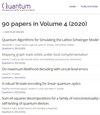Multidimensional Electrical Networks and their Application to Exponential Speedups for Graph Problems
IF 5.1
2区 物理与天体物理
Q1 PHYSICS, MULTIDISCIPLINARY
引用次数: 0
Abstract
Recently, Apers and Piddock [TQC '23] strengthened the connection between quantum walks and electrical networks via Kirchhoff's Law and Ohm's Law. In this work, we develop a new multidimensional electrical network by defining Alternative Kirchhoff's Law and Alternative Ohm's Law based on the multidimensional quantum walk framework by Jeffery and Zur [STOC '23]. In analogy to the connection between the incidence matrix of a graph and Kirchhoff's Law and Ohm's Law in an electrical network, we rebuild the connection between the alternative incidence matrix and Alternative Kirchhoff's Law and Alternative Ohm's Law. This new framework enables generating an alternative electrical flow over the edges on graphs, which has the potential to be applied to a broader range of graph problems, benefiting both quantum and classical algorithm design.We first use this framework to generate quantum alternative electrical flow states and use it to find a marked vertex in one-dimensional random hierarchical graphs as defined by Balasubramanian, Li, and Harrow [arXiv '23]. In this work, they generalised the exponential quantum-classical separation of the welded tree graph by Childs, Cleve, Deotto, Farhi, Gutmann, and Spielman [STOC '03] to random hierarchical graphs. Our result partially recovers their results with an arguably simpler analysis.
Furthermore, this framework also allows us to demonstrate an exponential quantum speedup for the pathfinding problem in a type of regular graph, which we name the welded tree circuit graph. The exponential quantum advantage is obtained by efficiently generating quantum alternative electrical flow states and then sampling from them to find an s-t path in the welded tree circuit graph. By comparison, Li [arXiv '23] constructed a non-regular graph based on welded trees and used the degree information to achieve a similar speedup.
多维电网络及其在图问题指数加速中的应用
最近,Apers和Piddock [TQC '23]通过基尔霍夫定律和欧姆定律加强了量子行走与电网络之间的联系。在这项工作中,我们基于Jeffery和Zur [STOC '23]的多维量子行走框架,通过定义可选Kirchhoff定律和可选欧姆定律,开发了一个新的多维电网络。类似于电网络中图的关联矩阵与基尔霍夫定律和欧姆定律的关系,我们重建了图的关联矩阵与基尔霍夫定律和欧姆定律的关系。这个新框架能够在图形的边缘上生成替代电流,这有可能应用于更广泛的图形问题,有利于量子和经典算法设计。我们首先使用该框架来生成量子可选电流状态,并使用它来寻找由Balasubramanian, Li和Harrow [arXiv '23]定义的一维随机分层图中的标记顶点。在这项工作中,他们将Childs, Cleve, Deotto, Farhi, Gutmann和Spielman [STOC '03]的焊接树图的指数量子经典分离推广到随机分层图。我们的结果用一个简单的分析部分地恢复了他们的结果。此外,该框架还允许我们在一种正则图(我们将其命名为焊接树电路图)中展示指数量子加速寻路问题。指数量子优势是通过有效地产生量子交替流态,然后从中采样以在焊接树电路图中找到s-t路径来获得的。相比之下,Li [arXiv '23]基于焊接树构造了一个非正则图,并利用度信息实现了类似的加速。
本文章由计算机程序翻译,如有差异,请以英文原文为准。
求助全文
约1分钟内获得全文
求助全文
来源期刊

Quantum
Physics and Astronomy-Physics and Astronomy (miscellaneous)
CiteScore
9.20
自引率
10.90%
发文量
241
审稿时长
16 weeks
期刊介绍:
Quantum is an open-access peer-reviewed journal for quantum science and related fields. Quantum is non-profit and community-run: an effort by researchers and for researchers to make science more open and publishing more transparent and efficient.
 求助内容:
求助内容: 应助结果提醒方式:
应助结果提醒方式:


